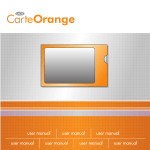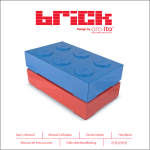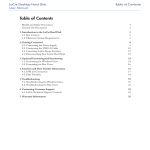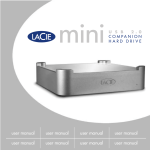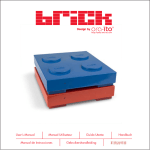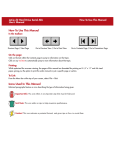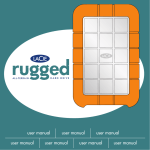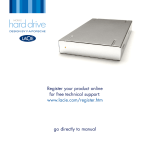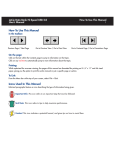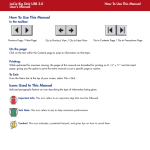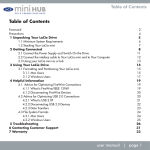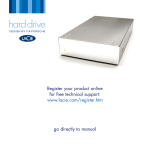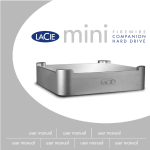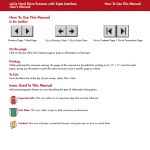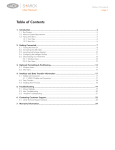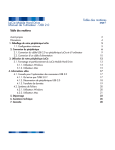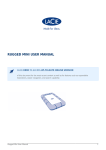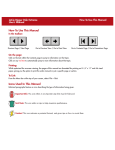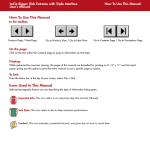Download user manual user manual user manual user manual user manual
Transcript
user manual user manual user manual user manual user manual user manual user manual Table of Contents Table of Contents Foreword Precautions 1. Introduction 1.1. What Your LaCie Drive Can Do 2. Your LaCie Drive 2.1. Minimum System Requirements 2.2. Package Contents And Views Of The Drive 2.2.1. Package Contents 2.2.2. Views Of The Drive 2.3. Cables And Connectors 2.3.1. USB 2.3.2. USB Power Cable 3. Installing Your LaCie Drive 3.1. Connect the USB 2.0 Cable to LaCie Rugged and to your computer 3.2. Disconnecting Your LaCie Drive 4. Using Your LaCie Drive 4.1. Formatting And Partitioning Your LaCie Rugged Drive 4.1.1. Mac Users 4.1.2. Windows Users 5. Tech Tips 5.1. File System Formats 5.1.1. Mac Users 5.1.2. Windows Users 5.2. Available Storage Capacity 5.3. Optimizing Data Transfers 5.3.1. Hi-Speed USB 2.0 Ports And Performance 6. USB Questions & Answers user manual 4 6 7 7 8 8 9 9 10 11 11 12 13 16 17 18 20 20 22 24 24 24 26 27 27 28 29 | page 2 Table of Contents 7. Troubleshooting 7.1. Mac Users 7.2. Windows Users 8. Contacting Customer Support 9. Warranty 30 31 35 38 40 user manual | page 3 Foreword Copyrights Copyright © 2005 LaCie. All rights reserved. No part of this publication may be reproduced, stored in a retrieval system, or transmitted in any form or by any means, electronic, mechanical, photocopying, recording or otherwise, without the prior written consent of LaCie. Trademarks Apple, Mac, Macintosh and FireWire are registered trademarks of Apple Computer, Inc. Microsoft, Windows 98, Windows 98 SE, Windows 2000, Windows Millennium Edition and Windows XP are registered trademarks of Microsoft Corporation. Sony and iLink are registered trademarks of Sony Electronics. Other trademarks mentioned in this manual are the property of their respective owners. Changes The material in this document is for information only and subject to change without notice. While reasonable efforts have been made in the preparation of this document to assure its accuracy, LaCie assumes no liability resulting from errors or omissions in this document, or from the use of the information contained herein. LaCie reserves the right to make changes or revisions in the product design or the product manual without reservation and without obligation to notify any person of such revisions and changes. FCC Statement: LaCie Rugged Hard Drive Warning: Modifications not authorized by the manufacturer may void the user’s authority to operate this device. Tested To Comply With FCC standards NOTE: This equipment has been tested and found to comply with the limits for a Class A digital device, pursuant to Part 15 of the FCC Rules. These limits are FOR HOME OR OFFICE USE designed to provide reasonable protection against harmful interference when the equipment is operated in a commercial environment. This equipment generates, uses, and can radiate radio frequency energy and, if not installed and used in accordance with the instruction manual, may cause harmful interference to radio communications. Operation of this equipment in a residential area is likely to cause harmful interference in which case the user will be required to correct the interference at his own expense. NOTE: This equipment has been tested and found to comply with the limits for a Class B digital device, pursuant to Part 15 of the FCC Rules. These limits are designed to provide reasonable protection against harmful interference in a residential installation. This equipment generates, uses and can radiate radio frequency energy and, if not installed and used in accordance with the instructions, may cause harmful interference to radio communications. However, there is no guarantee that interference will not occur in a particular installation. If this equipment does cause harmful interference to radio or television reception, which can be determined by turning the equipment off and on, the user is encouraged to try and correct the interference user manual | page 4 Foreword by one or more of the following measures: • Reorient or relocate the receiving antenna. • Increase the separation between the equipment and receiver. • Connect the equipment into an outlet on a circuit different from that to which the receiver is connected. • Consult the dealer or an experienced radio/TV technician for help. Canada Compliance Statement This Class A digital apparatus meets all requirements of the Canadian Interference-Causing Equipment Regulations. Manufacturer’s Declaration for CE Certification We, LaCie, solemnly declare that this product conforms to the following European standards: Class B EN60950, EN55022, EN50082-1, EN61000-3-2 With reference to the following conditions: 73/23/EEC Low Voltage Directive 89/336/EEC EMC Directive user manual | page 5 Precautions Health And Safety Precautions Only qualified persons are authorized to carry out maintenance on this device. • Read this User's Guide carefully, and follow the correct procedure when setting up the device. • Do not open your hard drive or attempt to disassemble or modify it. Never insert any metallic object into the drive to avoid any risk of electrical shock, fire, short-circuiting or dangerous emissions. Your hard drive contains no user-serviceable parts. If it appears to be malfunctioning, have it inspected by a qualified LaCie Technical Support representative. • Never expose your device to rain, or use it near water, or in damp or wet conditions. Never place objects containing liquids on the drive, as they may spill into its openings. Doing so increases the risk of electrical shock, short-circuiting, fire or personal injury. General Use Precautions: • Do not expose the hard drive to temperatures outside the range of 5° C to 35° C (41° F to 95° F) in operating mode. Doing so may damage the drive or disfigure its casing. Avoid placing your drive near a source of heat or exposing it to sunlight (even through a window). Inversely, placing your drive in an environment that is too cold or humid may damage the unit. • Always unplug the hard drive from the electrical outlet if there is a risk of lightning or if it will be unused for an extended period of time. Otherwise, there is an increased risk of electrical shock, short-circuiting or fire. • Do not use the hard drive near other electrical appliances such as televisions, radios or speakers. Doing so may cause interference which will adversely affect the operation of the other products. • Do not place the drive near sources of magnetic interference, such as computer displays, televisions or speakers. Magnetic interference can affect the operation and stability of your hard drive. • Do not place heavy objects on top of the drive or use excessive force on it. • Never use excessive force on your drive. If you detect a problem, consult the "Troubleshooting" section in this manual. • Protect your hard drive from excessive exposure to dust during use or storage. Dust can build up inside the device, increasing the risk of damage or malfunction. • Never use benzene, paint thinners, detergent or other chemical products to clean the outside of the drive. Such products will disfigure and discolor the casing. Instead, use a soft, dry cloth to wipe the device. Warning: The drive's warranty may be void as a result of the failure to respect the precautions listed above. user manual | page 6 1. Introduction 1. Introduction Thank you for the purchase of your new LaCie Rugged Drive. This rugged hard drive system combines portability with compatibility, convenience and a generous storage capacity to help you manage your data. Your LaCie external hard drive system is cross-platform, which enables you to use it on both Macs and PCs; it can be connected via USB interfaces; and you can customize the format and partitions of your LaCie drive to match your exact needs. LaCie’s Hard Drive is ideally suited for a wide range of high-end, high-traffic environments, including: • Digital content creation • Professional data exchange • Video on the go The LaCie Rugged Drive sports a tough metal and rubber case, which, along with its shock-resistant design, allows you to take it almost anywhere. This plug and play drive with a USB interface, allows you to connect the drive almost anywhere. 1.1. What Your LaCie Rugged Drive Can Do • Connects to all standard USB interfaces • Back up your computer’s internal hard drive. • Store and exchange data among several computers. user manual | page 7 2. Your LaCie Drive 2. Your LaCie Drive 2.1. Minimum System Requirements Mac Users Hi-Speed USB 2.0 Hardware Requirements for USB: • G3 or greater, with USB 2.0 or 1.1 interface card System Requirements for USB: • OS 9.x and 10.x (Apple USB support 1.3.5 and greater) Windows Users Hi-Speed USB 2.0 Hardware Requirements for USB: • Pentium II or higher -compatible processor, with a USB 2.0 or 1.1 interface card • 128MB RAM or greater System Requirements for USB: • Windows 98SE, Windows Me, Windows 2000 and Windows XP user manual | page 8 2. Your LaCie Drive 2.2. Package Contents and Views of the Drive 2.2.1. Package Contents 1 LaCie Rugged Drive 2 Hi-Speed USB 2.0 cable 3 USB Power Cable 4 LaCie Storage Utilities CD-ROM 1 2 4 3 Important Note: Please keep your box. In the event that the drive should need to be repaired or serviced, it must be returned in its original packaging. user manual | page 9 2. Your LaCie Drive 2.2.2. Rear View of the Drive 1 2 Hi-Speed USB 2.0 Port - This is where you plug in the Hi-Speed USB 2.0 cable furnished with the drive. See section 3.1. Connecting the Interface Cable for more information. Power connection - This is where you plug the optional USB Power Cable. For more information, see section 2.3.2. USB Power Cable. 1 2 user manual | page 10 2. Your LaCie Drive 2.3. Cables and Connectors 2.3.1. USB USB is a serial input/output technology for connecting peripheral devices to a computer or to each other. Hi-Speed USB 2.0 is the latest implementation of this standard, and it provides the necessary bandwidth and data transfer rates to support high-speed devices such as hard drives, CD/DVD drives and digital cameras. USB Icons These icons will help you easily identify the USB interfaces. They appear on USB cables and next to the USB port connectors on certain computers. Benefits of the USB standard include: • Backwards compatibility: Hi-Speed USB 2.0 works with the original USB specifications. • Hot-swappable: no need to shut down or restart your computer when adding or removing devices. USB 2.0 icon USB 1.1 icon Please see 7. USB Questions And Answers for a more detailed discussion of USB’s uses and capabilities. USB Cables Your LaCie drive is shipped with a Hi-Speed USB 2.0 cable, to ensure maximum data transfer performance when connected to a Hi-Speed USB 2.0 port. The cable will also work when connected to a USB port, but drive performance will be limited to USB 1.1 transfer rates. Hi-Speed USB 2.0 2.0 cable: Connects USB devices to USB ports. user manual | page 11 2. Your LaCie Drive 2.3.2. USB Power Cable In the event that the USB bus on your computer does not provide the necessary power to operate your drive, the included USB Power Cable connects to an available USB port on your computer. The USB ports (either USB 2.0 or USB 1.1) on your computer will help provide power to your LaCie drive. 1 2 Attach the small end of the USB Power Cable to the back of your LaCie drive. 2 Attach the USB end of the USB Power Cable to an available USB port on your computer. 1 user manual | page 12 3. Installing Your LaCie Drive 3. Installing Your LaCie Drive Getting your LaCie Rugged Drive installed and connected as simple as connecting an interface cable to the drive and to a computer. The Rugged Drive is plug & play for Windows 2000, Windows XP and Mac OS X. If you’re using one of those operating systems, move ahead to section 3.1 Connecting the USB 2.0 Cable to your Computer. Important Note: Mac OS 9.x users: You must install Silverlining Pro software. For details see the following pages for installation steps.. Windows 98SE and Windows Me users: You must install the included driver software and Silverlining 98. See the following pages for installation steps. Important Note: This LaCie drive is preformatted in FAT32, allowing for cross-platform use in a (Mac/Windows) environment. Please see the following sections for more information about optimizing the drive’s performance: 4.1. Formatting And Partitioning Your LaCie Drive 5.1. File System Formats user manual | page 13 3. Installing Your LaCie Drive Mac OS 9.x – USB To use your new LaCie Rugged Drive, first install the necessary driver software. Silverlining Pro Installation 1) Insert the LaCie Storage Utilities CD in your computer’s internal CD/DVD drive. 2) Open the CD icon, double-click the Silverlining Software folder and doubleclick on the Silverlining Installer. 3) The Silverlining Utilities screen appears. Click on Continue. 4) The About to Install screen appears. Read the following information and click on Continue. 5) The License Agreement screen appears. Click on Agree. 6) The Installation screen appears. 7) Leave the installation setting at Easy Install unless you want to customize the installation process. 8) Click on Install. 9) A message appears to confirm that the installation was successful. 10) Click on Restart to use your USB peripheral immediately. Now you are ready to move to the next step, Connecting the Drive to the Computer. user manual | page 14 3. Installing Your LaCie Drive Windows 98 SE and Windows Me Users Only! Silverlining 98 and USB 2.0 Driver Installation To use your new LaCie Hard Drive, first install the necessary driver software and then Silverlining 98. Follow the steps below to install the necessary drivers and software to configure your drive. Then move on to the USB 2.0 installation steps. Step 1) Insert the LaCie Storage Utilities CD-ROM in your computer’s internal CD/DVD drive and open the disc (Fig.2.2). A) Double-click the USB 2.0 Drivers Install folder. B) Double-click on the LaCie_USB_Driver_Install.exe icon. The LaCie USB2 Storage Driver screen will appear. Click on Next. C) Installation will finish automatically. Step 2) Re-open the LaCie Storage Utilities CD-ROM. Step 2) Step 1) A) Double-click the Silverlining 98 folder. B) Double-click the Silverlining98_Install.EXE icon. C) Silverlining 98 will then initialize the install screen. D) The “Welcome” screen will appear. Click Next. E) The “Destination Location” screen will appear. To alter the location where the software is installed on your system, click the Browse button. If you do not want to change the location, do not click on the Browse button, and allow the software to be installed in its default location. Click Next to continue. Fig.2.2 F) Next is the “Start Installation” screen. Click Next. G The software installation will begin, and you will see the installation screens. H) Finally, you will see the “Silverlining 98 has been installed correctly” screen. Click Finish to complete the installation. user manual | page 15 3. Installing Your LaCie Drive Step 3.1 – Connect the USB 2.0 Cable to your LaCie Rugged and to your computer 1 Connect the USB cable to your drive. 2 Connect the cable to your computer. After a few seconds, your LaCie Rugged Drive will mount on your computer. Tech Note: Please refer to sectiona 5.3.1 Hi-Speed USB 2.0 Ports and Performance and 6. USB Questions and Answers for important information on disconnecting USB 2.0 devices and ensuring optimum performance. To achieve USB 2.0 speeds, your drive must be connected to a USB 2.0 host port. If it is connected to a USB 1.1 port, your drive will operate at USB 1.1 speeds. For more details, see 5.3.1 Hi-Speed USB 2.0 Ports and Performance and 6. USB Questions and Answers. Important Note: Windows Users: It may take a few seconds for your computer to recognize the drive and assign it a letter. Mac Users: It may take a few seconds for the drive to appear on your desktop. Mac OS 9.x Mac OS 10.x user manual | page 16 3. Installing Your LaCie Drive 3.2. Disconnecting Your LaCie Drive USB external devices feature “plug & play” connectivity, which means that your drive can be connected and disconnected while the computer is running. To prevent failures, it is important you follow these steps when disconnecting your USB peripheral device. Warning: Do not disconnect the USB cable when the drive is reading or writing. Disconnecting while the drive is operating could cause the loss of data. Make sure that your drive is not reading or writing before disconnecting the USB cable. Windows Users 1 From the System Tray (located in the lower right-hand side of your screen), click on the Eject icon (a small green arrow over a hardware image). 2 A message will appear, detailing the devices that the Eject icon controls, i.e. “Safely remove…” Click on this prompt. 3 You will then be given the following message: “Safe to Remove Hardware” (or similar). It is now safe to disconnect the device. Mac Users You must unmount the hard drive system before disconnecting it or powering it down. Either: • Drag the hard drive icon to the trash. • Launch Silverlining Pro, highlight the hard drive and select “Unmount.” The drive can now be disconnected. Mac OS 10.x Mac OS 9.x user manual | page 17 4. Using Your LaCie Drive 4. Using Your LaCie Drive Once you’ve connected your drive and it is recognized by your operating system Important Note: If you will be using (i.e. Windows 98SE, Me, 2000, XP or Mac OS 9.x or 10.x), you are ready to this drive between Mac and Windows format and partition the drive. In order to store information on a hard drive, it must have a file system and be divided into sections that will contain the data that operating environments, you can create two partitions: one 32GB FAT 32 volume, you wish to store. This process is called formatting. and one large Mac OS Extended volume. In order to utilize a hard disk drive, it has to be formatted first. Formatting a disk There are certain limitations to this configuration, though; to achieve the best consists of the following: the operating system erases all of the bookkeeping performance and reliability, it is information on the disk, tests the disk to make sure that all of the sectors are recommended that you utilize a thirdreliable, marks bad sectors (i.e., those that are scratched) and creates internal address tables that it later uses to locate information. Once formatted, the actual party utility, such as Mediafour’s MacDrive, which allows Windows available storage capacity varies, depending on operating environment, and is computers to read and write files on a generally about 10% less than the non-formatted capacity. volume formatted for the Mac. Important Note: The LaCie Rugged is preformatted in FAT 32, Mac Users so if you want to use another file system, you will need to reformat the hard drive. The following information will help you • If you will be using the drive in a strictly Mac OS environment, reformat the drive as one large Mac OS decide which file system format to use. Extended volume. After you’ve formatted the drive, you will have the opportunity • If you want to be able to install multiple Mac operating to divide the hard drive into sections, called Partitions. A systems on the LaCie Rugged Drive, partition the drive into partition is a section of the hard drive’s storage capacity that is multiple Mac OS Extended volumes. created to contain files and data. For instance, you could create three partitions on your drive: one partition for your word documents, one for your spreadsheets and one for your multi-media files. File System Formats There are essentially three different file system formats: FAT 32, NTFS, and Mac OS Extended (HFS+). Windows Users • If you will be using this drive betweenWin Me, 2000 or XP environments, it is recommended that you create two partitions: one that is a 32GB FAT 32 (MS-DOS File System) volume, and the other as a large NTFS volume. • If you will be using the drive in a strictly Win 2000/XP environment, create one large NTFS volume. user manual | page 18 Foreword Use FAT 32 if: • you will be using your drive between both Windows and Mac OS 9.x or 10.x; or sharing the drive between Windows 98 SE, Me, 2000 or XP Use NTFS if: • you will be using the drive only under Windows 2000 or Windows XP; performance will be generally greater when compared to FAT 32 Use HFS+ if: • you will be using the drive on Macs only; performance will be generally greater when compared to FAT 32 For more information, please refer to section 5. Tech Tips File System Formats. user manual | page 19 4. Using Your LaCie Drive 4.1. Formatting And Partitioning Your LaCie Rugged Drive Once you have set-up your LaCie Rugged Drive, you can reformat or partition it to suit your needs. 4.1.1. Mac Users • Mac OS 9.x – Install and use LaCie Silverlining Pro, which is included with your drive. • Mac OS 10.x – Use the Apple Disk Utility application, which is native to the operating system. For instructions on installing and using Silverlining Pro, please refer to the Silverlining manual, located on your LaCie Storage Utilities CD, in PDF format. Warning: Following these steps will erase anything that is on the hard drive. Therefore, if you have information that you want to protect or continue to use, backup this information before performing these steps. Formatting And Partitioning Using Mac OS 10.x 1) Connect the drive to the computer via one of the interface ports. 2) Once the drive mounts onto the desktop, go to the Menu Bar, and open Go. 3) From the Go menu, click on Applications. 4) In the Applications menu, open the Utilities folder, and then double-click Disc Utility from the Utilities folder. 5) The Disc Utility window will open. In the left side of the window will be a list of the available hard disk drives. You should see a volume that represents your internal hard drive, and one that reads LaCie. 6) Select the LaCie drive, and then click on the Partition tab. user manual | page 20 4. Using Your LaCie Drive 7) From the Volume Scheme: button, choose the number of partitions you want to divide the drive into by clicking on the pull down menu starting with Current (Mac OS 10.x gives you the option of dividing the drive into at most 8 partitions). You can customize the size of the partitions by using the slide bar between the partitions in the Volume Scheme: area. 8) In the Volume Information section, create a name for each partition, choose the volume format (Mac OS Extended, Mac OS Standard, MS-DOS File System or UNIX File System) and the volume size. 9) In the Options section, click the Install Mac OS 9 Disk Drivers box if you plan on sharing the drive between the Mac OS 9.x and Mac OS 10.x. Tech Note:For a more detailed discussion on the various file system formats and partitioning, please refer to section 5.1.1. File System Formats – Mac Users. Tech Note:Under Mac OS 10.3.x, the default format setting is Mac OS Extended (Journaled). Journaling provides a continuous record of changes to files on the hard drive. You will not be able to format in the MS-DOS File System, either, unless you choose the Erase tab in the Disc Utility window and create an entire MS-DOS File System volume. For more information, please refer to section 5.1.1. File System Formats - Mac Users. 10) Once you have finalized the volume format, number of partitions, size and options, click OK. The following message will appear: “Warning! Saving the new volume will erase all existing volumes. This can NOT be undone. Are you sure you want to do that?” Click Partition to continue. 11) Mac OS 10.x will automatically setup the disk with the partitions and volume format you selected, and your new drive will be available for use. user manual | page 21 4. Using Your LaCie Drive 4.1.2. Windows Users Warning: Following these • Windows 2000 and XP – Use the Disk Management Utility, which is native to the operating system. • Windows 98 SE and Me – Install and use LaCie Silverlining 98, which is included with your drive. steps will erase anything that is on the hard drive. Therefore, if you have information that you want to protect or continue to use, backup this information before performing these steps. Formatting And Partitioning Using Windows 2000 And Windows XP The process of formatting and partitioning a drive on a computer running Windows 2000 or Windows XP consists of two steps: (1) installing a signature on the drive, and (2) partitioning/formatting the drive. These steps will erase anything that is on the disk. 1) Connect the drive to the computer via one of the interface ports. 2) Right-click My Computer and click Manage. 3) From the Computer Management window, select Disk Management (located below the Storage group). 4) If this is the first time the drive is being formatted, Windows 2000 will launch the Write Signature Wizard (Write Initialize Wizard in Windows XP). Click Next. 5) Windows will list the new drive(s) attached. If you are formatting a single drive, only one drive should be visible. Select the checkbox next to the drive and click Next. Important Note: Check the "quick format" box. 6) Click Finish to exit the Wizard. 7) Now, with the disk management window open, a new drive will be visible. Right-click on the available space and select Create Partition... user manual | page 22 4. Using Your LaCie Drive 8) This will bring up the Create Partition Wizard. Click Next. 9) Select Primary Partition. Click Next. 10). Here you must specify partition size. It is recommended that you leave the partition set to the maximum available size, unless you want multiple partitions on the same drive. Click Next. 11) Select Assign drive letter and select the desired letter for the drive. Click Next. 12) Select Format this partition… and then select a file system: FAT32 FAT32 is a file system that is compatible with Windows 98 SE, Windows Me, Windows 2000 and Windows XP; however, it has limitations. In Windows 2000 and Windows XP, you will not be able to create a partition greater than 32GB. Tech Note: For a more detailed discussion on the various file system formats and partitioning, please refer to section 5.1.2. File System Formats – Windows Users. NTFS NTFS is a newer file system that is compatible only with Windows NT, Windows 2000 and Windows XP. It has fewer limitations than FAT 32 and will enable a partition to be created that is larger than 32GB. 13) Click Next. 14) Click Finish. 15) Disk Management will create the partition and begin formatting the drive. Once completed, close Disk Management and your new drive will be ready to use. user manual | page 23 5. Tech Tips 5. Tech Tips 5.1 File System Formats 5.1.1. Mac Users Important Note: If you will be sharing the hard drive between Mac and Windows operating environments, you will want to follow these guidelines: Mac OS 9.x • Works reliably with FAT 32 partitions less than 32GB Mac OS 10.x Users: The LaCie Rugged Drive is pre-formatted in FAT 32. You may customize the drive by reformatting and/or partitioning the drive with separate file system formats. For optimal peformance in Mac OS environments, format and partition the drive as one large Mac OS Extended volume. Mac OS X prefers that all paritions be the same format, therefore only the first FAT 32 partition is guaranteed to mount. Mac OS 10.1.x • Works reliably with FAT 32 partitions less than 32GB Mac OS 10.2.x Mac OS Extended (HFS+) • Works reliably with FAT 32 partitions less than Mac OS Extended refers to the file system used by Mac OS 8.1 128GB • Does not mount FAT 32 partitions greater than 128GB and later. HFS+ represents an optimization of the older HFS file system by using hard disk space more efficiently. With HFS+, you Mac OS 10.3.x • Mounts any FAT 32 drive of any size are no longer limited by block size. • Mounts NTFS volumes as READ-only MS-DOS File System (FAT 32) This is the Microsoft file system, more typically known as FAT 32. Tech Note: Mac OS 10.3.x Users - Mac OS This is the file system to use if you are going to be using your Extended (Journaled) Under Panther, Apple introduced LaCie Rugged Drive between Macs and Windows operating journaling to the Mac OS Extended file system, which systems. helps protect the file systems on Mac OS volumes. Mac OS Standard (HFS) When journaling is enabled, file system transactions are Mac OS Standard refers to the file system used by Mac OS 8.0 maintained and recorded continuously in a separate file, and earlier. Only use this file system if you are creating a volume called a journal. smaller than 32MB, using a Mac with a 680X0 processor or In the event of an unplanned shutdown, the OS uses the creating a file structure that will be need to be used by Macs journal to restore the file system. Journaling is also backward compatible, and all volumes with journaling running Mac OS 8.0 or earlier. enabled can be fully used by computers not running Mac OS 10.3.x. For more information, please visit Apple’s Web site. user manual | page 24 5. Tech Tips UNIX File System This is the file system based on UNIX, and is preferrable for users developing UNIX-based applications within Mac OS 10.x. Unless you have a specific reason to use the UNIX File System, you should instead format your drive using Mac OS Extended (HFS+), because it provides Mac users with a more familiar operating experience. Mac OS 9.x Users: You will be able to format the drive in one of two formats, HFS (Mac OS Standard) or HFS+ (Mac OS Extended), using Silverlining Pro (for specific instructions, please refer to the Silverlining User’s Manual, in the Silverlining folder). user manual | page 25 5. Tech Tips 5.1.2. Windows Users There are basically two file system formats for Windows: FAT 32 and NTFS. The following information will hopefully make choosing one or the other a little easier. FAT 32 FAT is an acronym for File Allocation Table, which dates back to the beginnings of DOS programming. Originally, FAT was only 16 bits, but after the second release of Windows 95 it was upgraded to 32 bits, hence the name FAT 32. In theory, FAT 32 volume sizes can range from less than 1MB all the way to 2TB. It is the native file system of Windows 98 and Windows Me, and is supported by Windows 2000 and XP. When FAT 32 is used with Windows 2000 and XP, though, volume size is limited to 32GB (by the Windows partition utility, i.e. Disk Manager), and the individual file size is limited to 4GB. NTFS This acronym stands for New Technology Filing System, and it is the native file system for Windows NT, Windows 2000 and XP. NTFS offers several features that are not available with FAT 32; i.e. file compression, encryption, permissions, and auditing, as well as the ability to mirror drives and RAID 5 capabilities. The minimum supported volume size for NTFS is 10MB, with a maximum of 2TB, with no limit to file size. Volumes created in NTFS can only be directly accessed (not through shares) by Windows NT, Windows 2000 and XP, without resorting to help from third-party products. Guidelines for Choosing FAT 32 Or NTFS Use FAT 32 if: • You want to access your data on any Operating System - FAT 32 is compatible with Windows 98 SE, Me, 2000, XP, NT, Mac OS 9.x and Mac OS 10.x (see Important Note: in section 5.1.1. File System Formats - Mac Users for more information). • You will be dual booting with an Operating System other than Windows NT or Windows 2000. • You may need the ability to dual boot down the line. Once you have converted a volume from FAT 32 to NTFS, there is no going back. You can convert from FAT 32 to NTFS, but not the other way around. Use NTFS if: • You want to optimize drive performance under Windows 2000 or XP. • You want to encrypt files, assign permissions to files, or want to audit files for access. • You will be formatting partitions larger than 32GB. • You need to store individual files that are larger than 4GB. • You need a filing system that can be mirrored or structured like a RAID 5 configuration. user manual | page 26 5. Tech Tips 5.2. Available Storage Capacity A gigabyte (GB) means 1,000,000,000 bytes. In order to utilize a hard disk drive, it has to be formatted first. Formatting a disk consists of the following: the operating system erases all of the bookkeeping information on the disk, tests the disk to make sure that all of the sectors are reliable, marks bad sectors (i.e., those that are scratched) and creates internal address tables that it later uses to locate information. Once formatted, the actual available storage capacity varies, depending on operating environment, and is generally about 10% less than the non-formatted capacity. 5.3. Optimizing Data Transfers Data transfers are the flow of data that accomplishes a task, usually related to moving Tech Note:Another important data from storage to computer RAM, or between storage devices. With external drives, factor in file transfer speeds is such as the LaCie Rugged Drive, the data is transferred from the drive to the computer via how the drive has been the USB interface. formatted. For more information in choosing the correct file system fomat, please see section 5.1 File System Formats. user manual | page 27 5. Tech Tips 5.3.1. Hi-Speed USB 2.0 Ports And Performance To utilize the enhanced Hi-Speed USB 2.0 performance, your computer must be equipped with a Hi-Speed USB 2.0 host bus adapter card (either sold separately, or integrated by your computer’s manufacturer) and the appropriate drivers. These host bus adapter cards, which include one or more USB ports, are shipped with special Hi-Speed USB 2.0 drivers that enable the computer to control the card. These drivers must be installed in order for USB 2.0 devices connected to the port to work at their correct speeds. Computers running Windows 2000 and Windows XP automatically manage Hi-Speed USB 2.0 devices and drivers. Mac OS 9.x does not support Hi-Speed USB 2.0 functionality, and all Hi-Speed USB 2.0 devices will only operate at the original USB specifications. Mac OS 10.2.7 and later supports Hi-Speed USB 2.0, and Mac OS 10.x also supports Hi-Speed USB 2.0, but you will have to purchase a third-party PCI or PC Card and appropriate drivers. Contact your LaCie reseller or LaCie Customer Support for information about Hi-Speed USB 2.0 PCI or PC Cards, or visit our Web site: www.lacie.com. user manual | page 28 6. USB Questions & Answers 6. USB Questions & Answers What Are The Benefits Of The USB Interfaces? • Cross-platform: Use your USB peripherals on both Mac and Windows platforms. • “Hot Swappable”: No need to shut down or restart your computer when adding or removing a USB device. Plug it in and its ready. • Automatic configuration: Once your device is connected, your computer recognizes the device and automatically configures the necessary software. • Easy Installation: One standardized port and plug combination makes it simple to connect. What Is The Difference Between USB And Hi-Speed USB 2.0? The main difference is speed. The original version of the interface is capable of throughput up to 12Mb/s. Hi-Speed USB 2.0 supports data speeds up to 480 Mb/s, making it 40 times faster than its predecessor. This increased bandwidth translates into higher performance in demanding applications requiring high transfer rates. What Are The Ideal Uses For USB? USB is perfect for more traditional connections such as keyboards, mice, joysticks and scanners. These types of devices don’t require fast data transfer rates, and operate very successfully at the slower speeds. What Are The Ideal Applications For Hi-Speed USB 2.0? Digital cameras, CD/DVD drives, hard drives and scanners will all benefit from the added bandwidth and performance gains of the new implementation of the USB standard. Hi-Speed USB 2.0 provides the necessary fast data transfer rates that today’s devices require, and combines the earlier specifications so older devices that operated under the original USB standards will still work with Hi-Speed USB 2.0. Will USB Devices Run Faster When Connected To A Hi-Speed USB 2.0 Bus? Unfortunately, no. The Hi-Speed USB 2.0 specification is specifically written to allow developers to design higher speed peripherals that can take advantage of the extra bandwidth. USB devices, though, will still operate at 12Mb/s at full-speed and 1.5Mb/s at low-speed on a Hi-Speed USB 2.0 bus. Even though USB devices won’t run any faster, they can work alongside Hi-Speed USB 2.0 devices on the same bus. However, if you plug in a Hi-Speed USB 2.0 device to a USB bus, the speed of the Hi-Speed USB 2.0 device will decrease to 12Mb/s. user manual | page 29 7. Troubleshooting 7. Troubleshooting In the event that your LaCie Rugged Drive is not working correctly, please refer to the following checklist to find out where the problem is coming from. If you have gone through all of the points on the checklist and your drive is still not working correctly, please have a look at the FAQs that are regularly published on our Web site – www.lacie.com. One of these FAQs may provide an answer to your specific question. You can also visit the drivers pages, where the most recent software updates will be available. If you need further assistance, please contact your LaCie reseller or LaCie Technical Support (see 9. Contacting Customer Service for details). Manual Updates LaCie is constantly striving to give you the most up-to-date, comprehensive User’s Manuals available on the market. It is our goal to provide you with a friendly, easy-to-use format that will help you quickly install and utilize the many functions of your new device. If your manual does not reflect the configurations of the product that you purchased, please check our Web site for the most current version available. user manual | page 30 7. Troubleshooting 7.1. Mac Users The Problem Questions to Ask Possible Solutions The drive is not recognized by the computer. Does your computer’s configuration meet the minimum system requirements for use with this drive? Check section 2.1. Minimum System Requirements – Mac Users for more information. Is the drive’s power sharing connected and turned on? Make sure that the power sharing is properly connected (see section 2.3.2. USB Power Sharing Cable). Did you follow the correct installation steps for the specific interface and operating system. Review the installation steps under 3.Installing Your LaCie Drive Is there an icon for the drive appear on the desktop? There should be an icon for the LaCie drive on the desktop. Open Apple System Profiler and click on the Devices and Volumes tab. If your device is not listed, follow the rest of the Troubleshooting tips to isolate the problem. Are both ends of the USB cable firmly attached? •Disconnect the USB cable, wait 10 seconds and then reconnect. •Ensure that the USB connectors are properly aligned. USB cables can only be inserted one way. Make sure that they are correctly oriented. •Check that the USB connectors are straight and fully seated int he USB ports. •Only use certified USB cables, such as the cables provided with your LaCie drive. If you have followed all of these steps and the drive is still not recognized, shut down your computer, wait 3 to 5 minutes, restart your computer and try again. user manual | page 31 7. Troubleshooting The Problem Questions to Ask Possible Solutions The drive is not recognized by the computer. Is the drive connected to the computer through a hub? Try connecting the drive directly to the computer. For best performance and reliability, connect the LaCie Rugged Drive directly to the computer. Has the drive been formatted? Make sure that the drive has been formatted properly. Please see sections 4.1. Formatting And Partitioning Your LaCie Drive and 5.1. File System Formats for more information. Is there a conflict with other device drivers or extensions? Contact LaCie Technical Support for help. The drive is working slowly. Is the LaCie Rugged Drive connected directly to the host computer? Make sure that your LaCie Rugged Drive is connected directly to the computer (see section 3.1. Connect The USB 2.0 Cable for more information). For more information, see section 5.3. Optimizing Data Transfers. user manual | page 32 7. Troubleshooting The Problem Questions to Ask Possible Solutions The drive is not running noticeably faster when connected via Hi-Speed USB 2.0. Are there other USB devices connected to the hub? Disconnect any other USB devices and see if the drive’s performance increases. Are you operating in Mac OS 9.x? Apple does not support the Hi-Speed USB 2.0 standard under Mac OS 9.x. You will be limited to the slower transfer rates of the original USB standard. For more information, please see 5.3.2. Hi-Speed USB 2.0 Ports And Performance. Are you operating in Mac OS 10.x? Apple has only recently begun incorporating native HiSpeed USB 2.0 ports in their computers. To achieve HiSpeed USB 2.0 transfer rates, you will need to add a HiSpeed USB 2.0 PCI or PC card to your computer. For more information, please see 5.3.2. Hi-Speed USB 2.0 Ports And Performance. Is the drive connected to a USB port on your computer, or to a USB hub? If your drive is connected to a USB port or hub, this is normal. A Hi-Speed USB 2.0 device can only operate at HiSpeed USB 2.0 performance levels when it is connected directly to a Hi-Speed USB 2.0 port or hub. Otherwise, the Hi-Speed USB 2.0 device will operate at the slower USB transfer rates. For more information, please see sections 5.3.2. Hi-Speed USB 2.0 Ports and Performance and 7. USB Questions And Answers. Is the drive connected to a HiSpeed USB 2.0 port on your computer? Check to see that the Hi-Speed USB 2.0 drivers for both your host bus adapter and device have been installed correctly. If in doubt, un-install the drivers and re-install them. Does your computer or operating system support HiSpeed USB 2.0? See sections 2.1. Minimum System Requirements – Mac Users and 5.3. Optimizing Data Transfers for more information. user manual | page 33 7. Troubleshooting The Problem Questions to Ask Possible Solutions Error messages under Mac OS 10.x. Did you get an “Error –50” message while copying to a FAT 32 volume? When copying files or folders from Mac OS 10.x to a FAT 32 volume, certain characters cannot be copied. These characters include, but are not limited to: ?<>/\: Check your files and folders to ensure that these types of characters are not being used. Did you get an error message telling you that the drive has been disconnected when coming out of sleep mode? Simply ignore this message. The drive will remount to the desktop. LaCie drives conserve power by spinning down when you set your computer to sleep mode, and when the computer is “woken” from sleep, it does not give the drive enough time to spin-up from its sleep mode. Did you have an improper shutdown, forced restart or power interuption? If this happens and you are running Mac OS 10.x, you can utilize Apple’s Disc Utility to check the status of the drive and recover from such an event. Please refer to Apple’s Web site article: Mac OS X: About Using Disc Utility and fsck for File System Management. Is the drive formatted as a NTFS volume? If the file cluster size is set at 4KB (which is the default setting under Windows), this may be too small. Reformat the drive and change the cluster size to 32KB. Unplanned shutdown. Mac OS 10.3.x “hangs” when you connect a LaCie Rugged Drive. This is normal. Your drive has an autoswitching power feature, which means that if your drive is The drive turns on and off connected to your computer, turning the computer on will automatically turn the drive on. when you turn your Likewise, turning the computer off will automatically turn the drive off. If you wish to power off computer on and off. the drive while it is connected to your computer, first make sure that your computer is not accessing the drive and then follow the steps in section 3.2. Disconnecting Your LaCie Drive. After you have disconnected the drive, push the blue On/Off button on the front of the drive to turn the drive off. user manual | page 34 7. Troubleshooting 7.2. Windows Users The Problem Questions to Ask Possible Solutions The drive is not recognized by the computer. Has the drive been formatted? Make sure that the drive has been formatted properly. See sections 4.1. Formatting And Partitioning Your LaCie Drive and 5.1. File System Formats for more information. Was the drive formatted as a removable disk? If the drive is configured as a removable disk drive under Windows Me, the removable setting will need to be rechecked each time that the drive is taken to a new system. To do this, go the Device Manager (Start > Settings > Control Panel > System > Device Manager) and click on the Drives Settings tab. Does your computer’s operating system support the file system? Check your computer’s documentation and see sections 4.1. Formatting And Partitioning Your LaCie Drive and 5.1. File System Formats for more information. Is there an icon for the drive in My Computer? Go into My Computer and look for an icon and drive letter assigned to the LaCie drive. If the drive does not appear, follow the rest of the Troubleshooting tips to isolate the problem. Does your computer’s Check section 2.1. Minimum System Requirements – configuration meet the minimum Windows Users for more information. system requirements for use with this drive? Did you follow the correct installation steps for the specific interface and operating system. Review the installation steps under 3.1. Connect The USB 2.0 Cable user manual | page 35 7. Troubleshooting The Problem Possible Solutions The drive is not recognized by the computer. •Ensure that the USB connectors are properly aligned. USB cables can only be inserted one way. Make sure that they are correctly oriented. •Check that the USB connectors are straight and fully seated int he USB port. •Only use certified USB cables, such as the cables provided with your LaCie drive. If you have followed all of these steps and the drive is still not recognized, shut down your computer, wait 3 to 5 minutes, restart your computer and try again. Windows 2000 Users: Go to Start > Settings > Control Panel > System > Hardware tab > Device Manager button > USB Controller. Click on the + sign next to the controller icon, and you should see your device listed. Windows XP Users: Go to Start > Control Panel > Performance and Maintenance > System > Hardware tab > Device Manager button > USB Controller. Click on the + sign next to the controller icon, and you should see your device listed. If you still can’t see your device, recheck the cables and try the other troubleshooting tips listed here. Contact LaCie Technical Support for help. user manual | page 36 7. Troubleshooting The Problem Questions to Ask Possible Solutions The drive is working slowly. Is the LaCie Rugged Drive connected directly to the host computer? Make sure that your LaCie Rugged Drive is connected directly to the computer (see section 3.1. Connect The Interface Cable for more information). The drive is not running noticeably faster when connected via Hi-Speed USB 2.0. Is the drive connected to a USB port on your computer, or to a USB hub? If your drive is connected to a USB port or hub, this is normal. A Hi-Speed USB 2.0 device can only operate at HiSpeed USB 2.0 performance levels when it is connected directly to a Hi-Speed USB 2.0 port or hub. Otherwise, the Hi-Speed USB 2.0 device will operate at the slower USB transfer rates. For more information, please see sections 5.3.2. Hi-Speed USB 2.0 Ports and Performance and 6. USB Questions And Answers. Is the drive connected to a HiSpeed USB 2.0 port on your computer? Check to see that the Hi-Speed USB 2.0 drivers for both your host bus adapter and device have been installed correctly. If in doubt, un-install the drivers and re-install them. Does your computer or operating system support HiSpeed USB 2.0? See sections 2.1. Minimum System Requirements – Windows Users and 5.3. Optimizing Data Transfers for more information. Are you using a certified HiSpeed USB 2.0 cable to connect your drive? Ensure that the cable you are using has been properly certified. The Hi-Speed USB 2.0 cable that was shipped with your LaCie drive has been properly certified and tested to comply with USB standards. This is normal. Your drive has an autoswitching power feature, which means that if your drive is The drive turns on and off connected to your computer, turning the computer on will automatically turn the drive on. Likewise, turning the computer off will automatically turn the drive off. If you wish to power off when you turn your the drive while it is connected to your computer, first make sure that your computer is not computer on and off. accessing the drive and then follow the steps in section 3.2. Disconnecting Your LaCie Drive. user manual | page 37 8. Contacting Customer Support 8. Contacting Customer Support Before You Contact Technical Support 1) Read the manuals and review the Troubleshooting section. 2) Try to isolate the problem. If possible, make the drive the only external device on the CPU, and make sure that all of the cables are correctly and firmly attached. If you have asked yourself all of the pertinent questions in the troubleshooting checklist, and you still can't get your LaCie drive to work properly, contact us via the provided Web link. Before contacting us, make sure that you are in front of your computer and that you have the following information on hand: • Your LaCie drive's serial number • Operating system(Mac OS or Windows) and version • Computer brand and model • Names of CD or DVD drives installed on your computer • Amount of memory installed • Names of any other devices installed on your computer user manual | page 38 9. Contacting Customer Support LaCie Asia, Singapore and Hong Kong Contact Us At: http://www.lacie.com/asia/contact LaCie Australia Contact Us At: http://www.lacie.com/au/contact/ LaCie Belgium Contact Us At: http://www.lacie.com/be/contact/ LaCie Canada Contact Us At: http://www.lacie.com/caen/contact/ (English) LaCie Denmark Contact Us At: http://www.lacie.com/dk/contact/ LaCie Finland Contact Us At: http://www.lacie.com/fi/contact LaCie France Contact Us At: http://www.lacie.com/fr/contact/ LaCie Germany Contact Us At: http://www.lacie.com/de/contact/ LaCie Italy Contact Us At: http://www.lacie.com/it/contact/ LaCie Japan Contact Us At: http://www.lacie.co.jp LaCie Netherlands Contact Us At: http://www.lacie.com/nl/contact/ LaCie Norway Contact Us At: http://www.lacie.com/no/contact/ LaCie Spain Contact Us At: http://www.lacie.com/es/support/request LaCie Sweden Contact Us At: http://www.lacie.com/se/contact/ LaCie Switzerland Contact Us At: http://www.lacie.com/chfr/contact LaCie United Kingdom & Ireland Contact Us At: http://www.lacie.com/uk/support/request LaCie USA Contact Us At: http://www.lacie.com/contact/ LaCie Grand Export Contact Us At: http://www.lacie.com/intl/contact/ user manual | page 39 9. Warranty 9. Warranty LaCie warrants your drive against any defect in material and workmanship, under normal use, for the period designated on your warranty certificate. In the event this product is found to be defective within the warranty period, LaCie will, at its option, repair or replace the defective drive. This warranty is void if: • The drive was operated/stored in abnormal use or maintenance conditions; • The drive is repaired, modified or altered, unless such repair, modification or alteration is expressly authorized in writing by LaCie; • The drive was subjected to abuse, neglect, lightning strike, electrical fault, improper packaging or accident; • The drive was installed improperly; • The serial number of the drive is defaced or missing; • The broken part is a replacement part such as a pickup tray, etc. • The tamper seal on the drive casing is broken. LaCie and its suppliers accept no liability for any loss of data during the use of this device, or for any of the problems caused as a result. LaCie will not, under any circumstances, be liable for direct, special or consequential damages such as, but not limited to, damage or loss of property or equipment, loss of profits or revenues, cost of replacement goods, or expense or inconvenience caused by service interruptions. Any loss, corruption or destruction of data while using a LaCie drive is the sole responsibility of the user, and under no circumstances will LaCie be held liable for the recovery or restoration of this data. Under no circumstances will any person be entitled to any sum greater than the purchase price paid for the drive. To obtain warranty service, call LaCie Technical Support. You will be asked to provide your LaCie product’s serial number, and you may be asked to furnish proof of purchase to confirm that the drive is still under warranty. All drives returned to LaCie must be securely packaged in their original box and shipped with postage prepaid. Register online for free technical support: www.lacie.com/register user manual | page 40








































